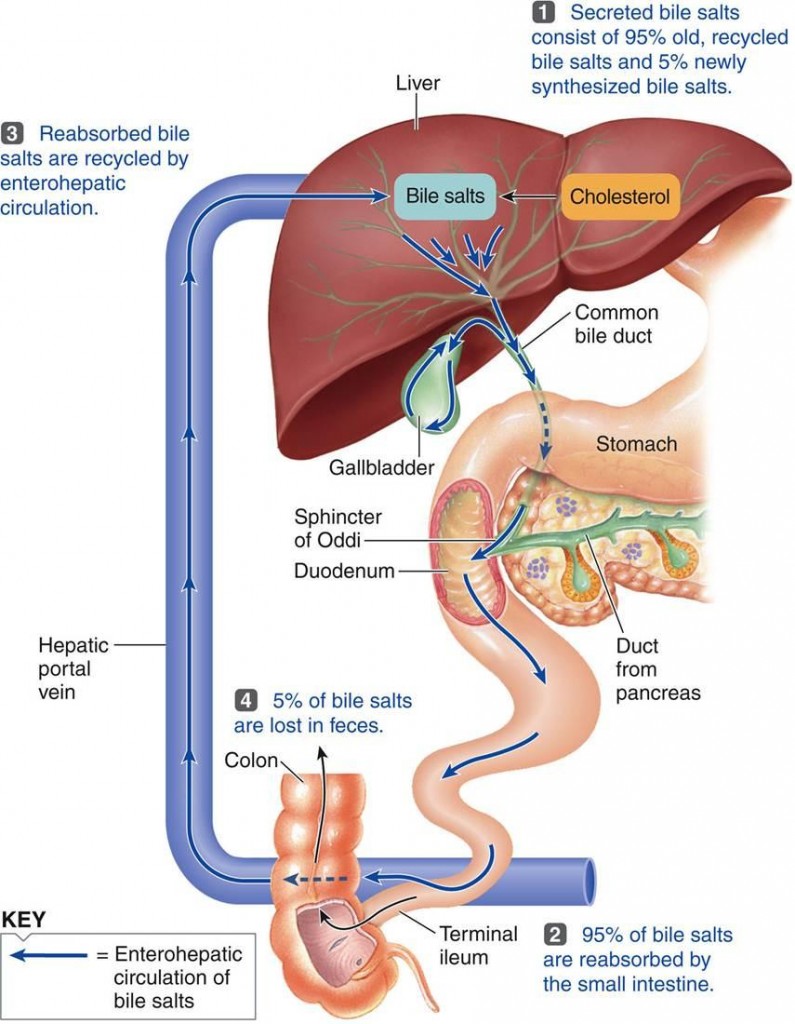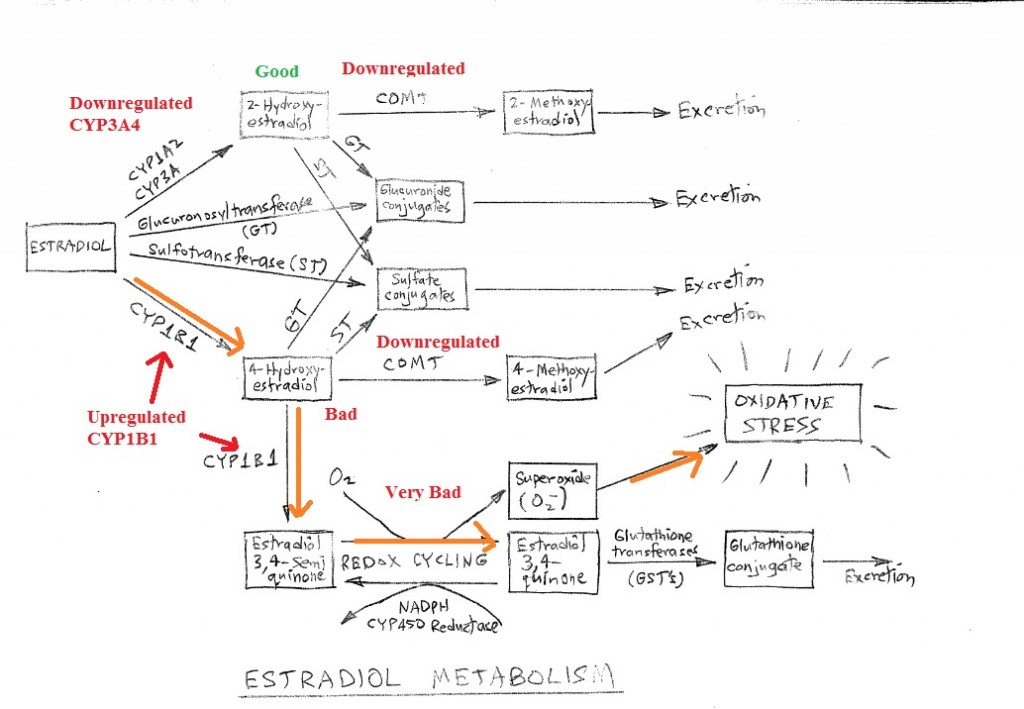Metabolic cholestatic pruritus
For the past year my girlfriend Adelle has been suffering from an unidentified ailment that caused extensive dry skin across the body and intense itching. No amount of moisturizing lotions or good fats in the diet such as coconut, omega 3s, fish oils, borage oil, primrose oil, olive oil, castor oil helped with the dry skin and antihistamines as well as corticosteroids could not relieve the itching. Recently Dr.Dan managed to identify it as “cholestatic pruritus” a condition where bile makes it’s way into the bloodstream.
It is thought that the itching is caused by serum bile acids interacting with opididergic nerves. This results in itching not only at the skin level but also deeper in the tissue where major blood vessels and nerves lie.
“Bile acids (also called bile salts) are produced in the liver, secreted into the biliary system, stored in the gall-bladder and are released after meals stimulated by cholecystokinin. They are important for the digestion and absorption of fats (lipids) in the small intestine. Usually over 95% of the bile acids are absorbed in the terminal ileum and are taken up by the liver and resecreted. This enterohepatic circulation of bile acids takes place 4-6 times in 24 hours and usually less than 0.5g /24h of bile acids enter the large intestine.” (source)
If however there are issues with the liver or the re-absorption process, bile can end up in the blood creating this condition.
Causes
There are many possible causes for this condition. Any number of liver diseases such as primary biliary cirrhosis, primary sclerosing cholangitis, obstructive choledocholithiasis, carcinoma of the bile duct, cholestasis (also see drug-induced pruritus), and chronic hepatitis C viral infection and other forms of viral hepatitis. There are two basic forms of choleostasis. Mechanical and biochemical. This post is only interested in the biochemical form.
The biochemical form appears to have a strong genetic component due the demographic clustering seen in cases of intrahepatic cholestasis in pregnancy or ICP for short. It most commonly occurs in the third trimester when hormone levels of estrogen and progesterone are at their highest. Thus it seems one of the factors of this metabolic form of cholestatic pruritus is due to hormone issues and metabolism of said hormones.
On a site note…
In the case of Adelle I was able to chart the exact pathways of her estrogen metabolism using the results using the Genova DetoxiGenomic genetic testing panel. A prior psoriasis like skin condition that afflicted her chest was due to a genetically preferred route of estrogen metabolism that created oxidative damage. I was able to remedy that problem with the use of DIM and Yerba Santa which contains potent CYP1B1 inhibitors. In all likelihood the above factors are also the primary cause of breast cancer. My theory is that in females who are parasympathetic dominant blood flow is closer to the skin which manifests as a skin problem, and those women who are more metabolically sympathetic dominant the blood flow is deeper in the tissue more likely causing tumorous breast cancer. If this is the case yerba santa and DIM could cure breast cancer!
Another note is that excess estrogen increases glycogen in tissues and can exacerbate any vaginal and skin yeast problems which can lead to further gut dysbiosis.
How this relates to metabolic cholestatic pruritus is that it has been found that elevated levels of estrogen glucuronides particularly estradiol-17β-D-glucuronides cause cholestasis in animals by reducing bile acid uptake in hepatocytes. This is done by inhibiting the bile salt export pumps.
Estradiol-17β-D-glucuronide is produced by the glucrodination of 2-OH-Estradiol using the Glucuronosyltransferase enzyme
E.Coli in the gut as well as some other bacteria produce the Beta-glucuronidase enzyme which takes the glucuronide off the estradiol-17β-D-glucuronide causing Estradiol-17β levels to rise and recirculate unnecessarily as they are not being excreted from the body.
In the case of Beta-glucuronidase enzymes the bacterium E.Coli produces this enzyme which is likely the root cause of elevated estradiol-17β-D-glucuronides. Thus the primary problem therefore could be too much E.Coli.
The following comes from the CDSA guide by Genova:
What is Beta-glucuronidase?
Beta-glucuronidase is an inducible enzyme elaborated by anaerobic E. coli, Peptostreptococcus, Bacteroides, and Clostridia. Increased activity of this enzyme has been implicated in increased enterohepatic recirculation of toxins, steroid hormones, drugs, and carcinogens.
What is the clinical significance of elevated beta-glucuronidase?
Ordinarily, toxins, hormones and drugs are excreted from the body after being conjugated to a glucuronide molecule. By uncoupling glucuronides in the intestine, beta-glucuronidase can deconjugate potential toxins, increasing the formation of carcinogens in the bowel and promoting the enterohepatic recirculation of toxins, hormones, and various drugs in the body.
The Cure
My theory is that perhaps some E.coli are camped out hiding under a protective biofilm right in the terminal ileum which is precisely the point bile is supposed to be taken back up by the liver.
A recent Iridology exam of Adelle confirmed this hypothesis as the Iridologist saw there was a problem in the ascending colon which is right next to the teriminal illeum where bile salts are reabsorbed into the body. This is a very strong indicator of bacterial imbalance/dysbiosis.
If certain gram negative Proteobacteria such as E.Coli are inhibiting the proper absorption of bile salts this can cause a vicious negative cycle. As bile salt concentrations increase they will kill the friendly bacteria allowing even more harmful bacteria to proliferate. The cycle repeats and can quickly escalate leading to high concentrations of bile salts not properly being transported to the liver and instead ending up in the blood stream where they create havoc on the body.
Not only this the excess gram negative Proteobacteria such as E.Coli can then cause hormonal imbalances specifically in regards to estrogen as estrogen is overly re-cycled leading to estrogen dominance. This can lead to further fungal issues as well.
This situation can be quickly remedied by taking Cholestyramine and binding the excess salts which gives the friendly bacteria a breather and prevents the salts from entering the bloodstream.. However this is more of a temporary band-aid type solution.
For a long term solution the underlying gut dysbiosis needs to be addressed, This is done by consuming adequate resistant starch which feeds the friendly bacteria which then kill and eliminate the bad bacteria.
Two specific strains of bacteria appear to be very good at replacing bad bacteria and that is L.Plantarum and B.Bifidus. It may important to start off slow with these as considerable die off of bad bacteria can occur leading to endotoxemia. Often things may get worse before getting better however sticking it out for the long haul is well worth it.
“Furthermore, it was determined that L. plantarum could be used to prevent the development of colitis since it has a protective effect on tight junction (TJ) associated proteins and TJ ultra-structure [14]. It has been hypothesized that the TJs might form a barrier in the epithelial layer that could prevent bile from penetrating the blood stream [16]. In other words, L. plantarum is capable of providing protection on the intestinal epithelium by reducing the permeability of the intestinal lining and can reduce the amount of pro-inflammatory proteins in the gastrointestinal tract.” (reference)
What’s more is that L.Plantarum is resistant to bile salts while many beneficial bacteria are not. L.Plantarum can help prevent the aforementioned viscous negative cycle as it can help mediate in an area where other probiotics cannot.
I am happy to report that Adelle now has no issue swith the cholestatic pruritus and all her itching symptoms have completely disappeared. As a side benefit her hormones have also stabilized and this treatment also cured her eczema!
Primary Treatment:
- Cholestyramine – This can cure the bulk of the itching in as little as an hour. It does this by binding to bile salts, preventing them from seeping into the blood. (this however is only a temporary solution!)
- Resistant Starch – is required for a long term solution to feed the good guys
- L. Plantarum & Bifido Bifidus – kill the bad guys that caused all the problems in the first place
Other potentially useful treatments:
- D-Mannose – Sticks to E.Coli helping take them out of the intestine. Take only temporarily in my opinion. L.Plantarum the species you want to replace E.Coli also binds to mannose therefore you do not want to inadvertently wash out the good guys as well.
- L-Aspartic Acid – Inhibitor of Beta-glucuronidase. http://www.ncbi.nlm.nih.gov/pubmed/11568288
- Calcium D-Saccharate Tetrahydrate – Inhibitor of Beta-glucuronidase also “It also blocks bacterial de-conjugation in the gut, which decreases biliary-intestinal re-circulation.” (source)
From the CDSA Guide. The following interventions may help to reduce beta-glucuronidase levels:
• Calcium-D-glucarate inhibits the enzyme. Foods with the highest concentration of calcium-D-glucarate include oranges, apples, grapefruit, and cruciferous vegetables.
• Silymarin (milk thistle).
• Probiotics (including Lactobacillus acidophilus, Lactobacillus rhamnosus GG, and bifidobacteria ).
• Fructooligosaccharides (FOS). FOS may act as a substrate for bifidobacteria. Combining FOS with cellulose may be even more effective.
•High-fiber diet (including both soluble and insoluble fiber)
•Ascorbic acid.
• Low- or non-meat diet. Lacto-vegetarian diets are associated with reduced levels of beta-glucuronidase.
• Lowering colonic pH. In vitro studies had shown thatraising fecal pHfrom 5 to 8 induces 11.5-fold increases in beta-glucuronidase levels.
Avoid:
- Cumin, cayenne or black pepper – these spices have been found to increase levels
of beta-glucuronidase.
Other Beta-glucuronidase inhibitors?
http://www.bulletproofexec.com/calcium-d-glucarate/
Related Posts
These are prior posts of mine that have led up to some of my theories in this post. Note, some of the info may be a bit dated.
- Curing Psoriasis & Eczema
- Fake Estrogen – a modern health epidemic
- Metabolic Diet & Supplements – an Exploration
Misc Notes:
Getting medical tests to confirm this condition is apparently very problematic. Tests for bile in the blood often give false indicators as it is hard to detect. If a doctor blindly believes lab reports this could be very problematic.
Also due to the unique nature of the itching I came up with the hypothesis it could be cause by excess beta-alanine instead of bile in the blood.
I know itching is very hard to quantify due to its subjective nature. You would know that bile in the blood is the issue if it relieved the itch if the Cholestyramine worked.
If not, there is another deep tissue itching that is caused by too much beta-alanine, which is made by candida and E.Coli. Adelle had elevated levels of this so it could have been a factor as well.
That one you can test by actually buying supplemental beta-alanine from a fitness supplement store. Adelle refused to try it, but a person could and this way if the itching is the same you would know at least what the cause is and then go after what’s causing it.
I have taken beta-alanine before and got the induced itch so I know exactly what it feels like. Some people don’t get an itch, and some need to take large amounts, so it really depends. But the itching sure is unlike a standard skin itch. It feels like it’s deep beneath the skin.
Regardless in both cases the underlying issue seems to be bacteria/fungal balance issue in the gut.


